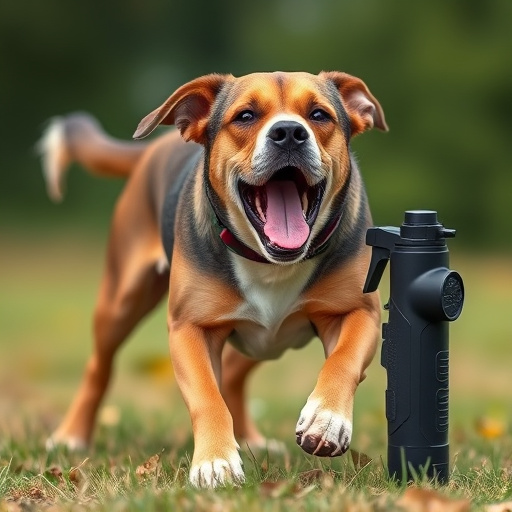Dog repellents, especially maximum-strength sprays with capsaicin and synthetic urine, irritate canines but are safe for humans. Always follow manufacturer instructions and ensure suitability for dogs or wildlife. Apply spray directly to fur, targeting scent glands, and use indoors as a disorienting cloud. Training remains the primary behavior deterrence method. In case of exposure, immediate emergency care is crucial; symptoms include irritation, swelling, vomiting, and seizures. Preventive measures include proper storage, label reading, rinsing affected areas, using activated charcoal, and seeking veterinary assistance promptly. Keeping dogs on leashes in public spaces also helps avert accidental exposure to repellents.
“Discover the power of Maximum Strength Dog Repellent Spray—a game-changer in keeping unwanted furry friends at bay. This comprehensive guide explores the science behind dog repellents, with a focus on potent sprays. Learn about active ingredients, their safety profiles, and effective application methods. Understand the precautions to ensure both pet and user safety. Additionally, gain insights into emergency care for affected animals, including symptoms, treatment options, and prevention strategies, offering a complete solution for effective and humane dog repulsion.”
- Understanding Dog Repellents: Active Ingredients and Safety
- Maximum Strength Spray: Application, Effectiveness, and Precautions
- Emergency Care for Affected Animals: Symptoms, Treatment, and Prevention Strategies
Understanding Dog Repellents: Active Ingredients and Safety
Dog repellents, especially maximum-strength sprays, are designed to keep dogs away from specific areas or objects. When choosing a repellent, understanding its active ingredients is key. Common active ingredients include capsaicin, a derivative of chili peppers, and synthetic urine, which imitates dog waste to deter other dogs. These ingredients are generally safe for humans but can be irritants to canine skin and eyes.
Safety is paramount when using any dog repellent, especially around pets and wild animals. Always follow the manufacturer’s instructions and ensure the repellent is labeled for use on dogs or wildlife. In cases of emergency care for maced animals, contact a local animal control service or veterinarian immediately. They can provide guidance tailored to the situation and help mitigate any potential harm caused by the repellent.
Maximum Strength Spray: Application, Effectiveness, and Precautions
Maximum Strength Spray: Application, Effectiveness, and Precautions
When it comes to using a maximum strength dog repellent spray, proper application is key. This potent formula should be sprayed directly onto the animal’s fur, focusing on areas where scent can be most effectively dispersed. For outdoor applications, target legs, paws, and the base of the tail, as these are common scent glands. For indoor situations or when dealing with a distressed animal, spray a cloud in front of the dog to disorient them while maintaining a safe distance.
The effectiveness of maximum strength sprays lies in their active ingredients, which are designed to mask canine scents that attract other animals. However, it’s important to remember that these products should be used as a last resort, especially when dealing with distressed or injured animals requiring emergency care for maced animals. Regular training and positive reinforcement remain the most humane and effective ways to deter unwanted behaviors. Always follow safety guidelines, keep these sprays out of reach of children and pets, and consult a vet if necessary.
Emergency Care for Affected Animals: Symptoms, Treatment, and Prevention Strategies
In the event that a dog is exposed to or ingests dog repellent spray, immediate emergency care is crucial. Symptoms may include excessive salivating, lip licking, irritation or swelling around the mouth and nose, vomiting, difficulty breathing, and in severe cases, seizures. If you suspect your dog has been affected by dog repellent spray, seek veterinary assistance promptly. Treatment involves thorough rinsing of the affected area with water, administering activated charcoal to absorb toxins, and providing supportive care as recommended by a veterinarian.
Prevention is key when it comes to Emergency Care for Affected Animals. Keep dog repellent sprays out of reach, ensuring they are stored securely in locked cabinets or areas inaccessible to pets. Regularly check the label for any warnings or instructions regarding usage and potential hazards. If your dog does come into contact with the spray, promptly remove them from the area, rinse their fur and skin, and seek veterinary attention as soon as possible. Additionally, keeping dogs on leashes in public spaces can help prevent accidental exposure to potentially harmful substances, including strong repellents.
When using maximum strength dog repellent spray, it’s crucial to understand its effects and take precautions. While effective in deterring dogs, proper application and awareness of potential symptoms are essential. In case of unintended exposure, emergency care for affected animals should be prompt, focusing on symptom management and prevention strategies to ensure their well-being. Remember, responsible use and awareness are key to maintaining a harmonious environment for both humans and canines.
